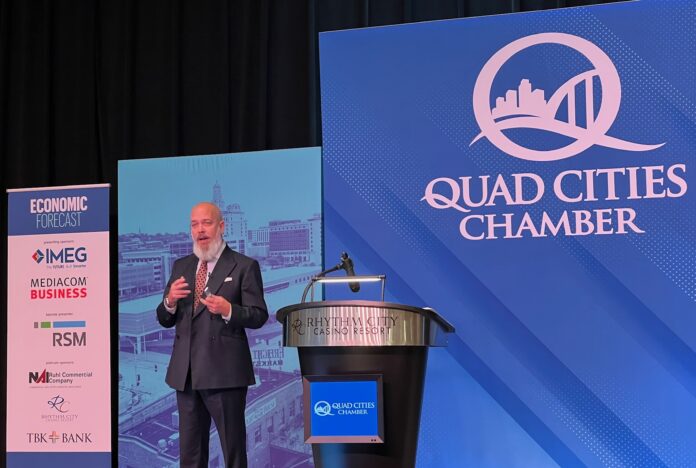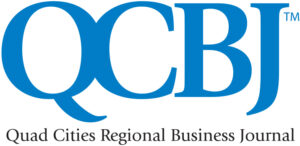
Though “everybody loves to hate” this economy, the U.S. is still in a good place, economist Kevin Depew told a crowd of about 350 business leaders gathered today for the Quad Cities Chamber’s 2024 Economic Forecast.
In his return trip to Davenport’s Rhythm City Casino, the deputy chief economist for RSM US LLP also said the probability of a recession, which was thought to be inevitable by many forecasters last year, has declined to around 30%.
And despite continued challenges like the credit crunch, higher interest rates, rising prices and lower supplies, and ongoing workforce challenges, there are a number of positive signs for the future, he said.
Chamber CEO LaDrina Wilson delivered a similar message about the QC to the business leaders attending the annual event, sponsored by RSM and headlined by Mr. Depew.
QC business on the rise
Ms. Wilson cited, for example, the chamber’s first-ever Business Outlook Survey conducted this month. In it, the majority of non-manufacturers who answered the survey reported experiencing increasing business activity in the last quarter.

Manufacturers’ results were mixed, with slightly more reporting a decrease in business activity than an increase. However, manufacturers and non-manufacturers alike expect an uptick in business activity in the next six months, the survey said. The results also suggest that hiring activity and capital investment will continue to be brisk among both manufacturers and non-manufacturers in the next six months.
Importantly, too, Ms. Wilson said, since the start of the fiscal year, the chamber has received 39 inquiries from businesses looking to move to the Quad Cities region.
“Now 39 in and of itself for folks who aren’t connected to this work may not seem like much but that’s a 50% increase from this time last year, so there’s a lot of business activity and people who are considering calling the Quad Cities their home,” she said.
Chamber staff have responded to 15 of those inquiries for which the Quad Cities had land or buildings available that met the requirements of businesses seeking new facilities, she said.
“If we were to actualize the potential there that would be a $2.4 million in capital investment and up to 2,500 jobs that would be created if these projects come to fruition,” she said.
“They won’t all happen but I’m trying to paint the picture for you to let you know that we are a community that people find attractive and where people can do business and feel like they can grow.”
Manufacturing job growth in the Quad Cities also was strong in 2022 with more than 1,000 jobs created. That brought manufacturing employment to levels not seen since before the “Great Recession” of 2008. There now are more than 25,000 manufacturing jobs in the area, which represents about 13% of all payroll jobs in the region. While manufacturing job growth slowed in 2023, it remains higher even in the face of rising interest rates.
Nationally, a disconnect
Despite positive signs locally and nationally, “there is a disconnect between how we feel about the economy and what the data show,” said Mr. Depew. “It’s the economy that everybody loves to hate.”
Challenges remain of course. Among those he highlighted were insufficient aggregate demand, insufficient supply, excess savings (or “”too much money sloshing around”) and the regionalization of our economy. The latter comes after years of trade hyperglobalization that began to accelerate due to emerging technologies in 1995.
That technological investment helped collapse borders and increased the number and affordability of the things Americans could and did buy, he said.
“It was a given that was underwriting a lot of the quality of life standards that we became accustomed to as we are able to manufacture goods in other parts of the world, providing much lower cost goods to us which had the effect of benefiting us and putting smartphones in everyone’s pockets,” he added,
That is changing, in part, due to trade regionalization, the impact of supply chain shocks and tensions with China, especially over semiconductor chips, which Mr. Depew called “really the building block” of the next 25 to 30 years.
American families are feeling the pinch of higher prices fueled in part by smaller regional rather than global markets and the rising cost of producing products that require significant technological investments.
Workforce challenges remain
Even as inflation and interest rates rose, workforce declines continued due in part to the decline in the U.S. birthrate.

Forecast at Rhythm City Casino, Davenport, Friday, Dec. 1, 2023. CREDIT QUAD CITIES CHAMBER
“The reality is that even though 700 jobs have been created here in the Quad Cities,” Mr. Depew said, “there’s still a little lack of labor supply and sometimes we just don’t find the people who have the right skill sets for the jobs that we’re hiring for.”
Meanwhile, he said, “We’re still creating jobs here that are industrial based but as we move toward an ecosystem that supports our high tech industry .. it’s simply going to cost us more to do that. “
And he said, “Surprisingly, household balance sheets on the aggregate are very strong. That’s not true for the bottom two quintiles of income earners but for the top three, which account for the majority of the spending in the economy and the majority of consumption the news is really good.”
The short term economy also is resilient, he added. Though the labor market remains tight, America is adding about 150,000 jobs per month. The nation only needs to add 65,000 to 70,000 jobs a month to report stable employment.
Robust holiday spending likely
Inflation continues to be a major issue despite it falling steadily from its peak rate of 9.1%, Mr. Depew said. But the current general price level “is obviously much higher and households are really starting to feel that.”
In spite of that, the RSM economist is predicting a 5% consumption rate for the holiday season. While that’s a little bit lower than last year, it’s “still quite robust.”
Plenty of challenges remain including the tight access to lending and “interest rate shock,” which have increased the real cost of doing business markedly, he added.
Still, however, Mr. Depew remains optimistic.
“The point is we are a wealthy economy,” he said. “We can afford to do things. We can afford to create a workforce for the next 20 years. We can afford to invest in infrastructure that benefits all of us, but there’s going to be prioritization needed. So what we need to figure out is where the priorities are.”
The U.S. also is expected to remain atop the global heap of economies.
“It’s likely that we’re still the cleanest shirt in a basket of dirty laundry, so if I assume that all the world’s economies are terrible, we are still the best one,” Mr. Depew said.
“And so as far as the global turmoil, even if it does increase and accelerate or move to other parts of the world, which we’ve seen recently, we are still going to be an attractive place to invest,” he added.
“Yes, the economy is resilient. Yes this is the economy that everybody loves to hate, but we’re still going to be in a good place.”




